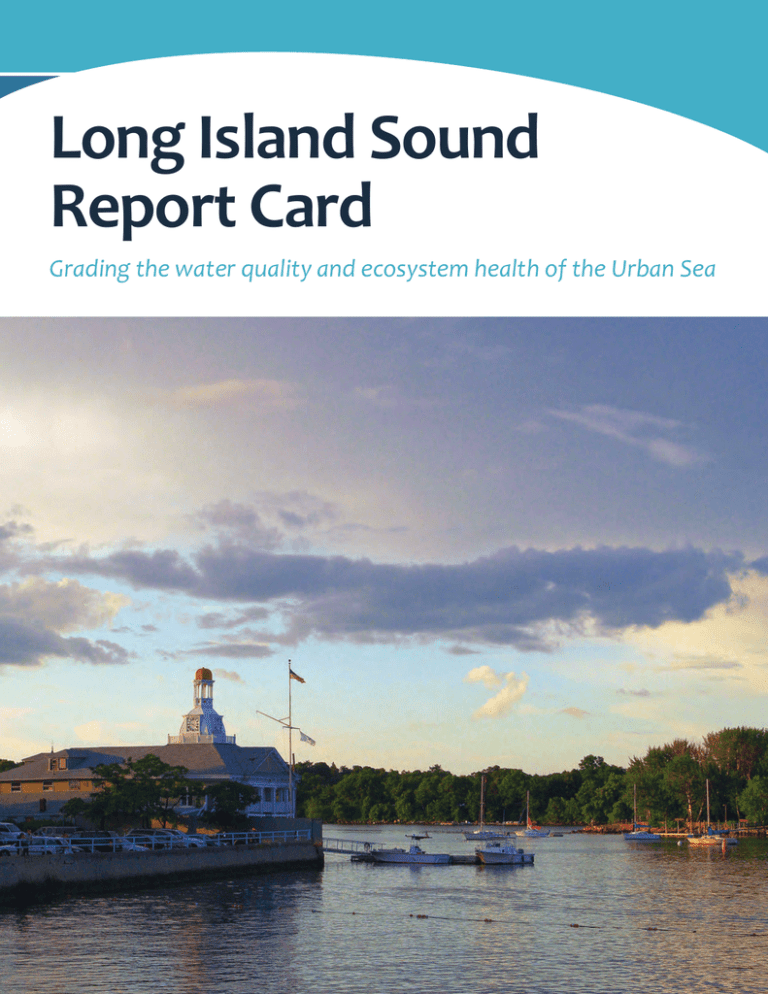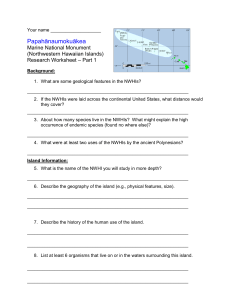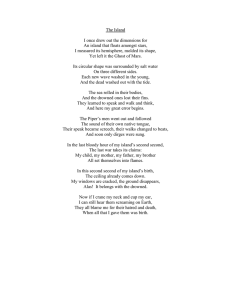Long Island Sound Report Card - Long Island Community Foundation
advertisement

Long Island Sound Report Card Grading the water quality and ecosystem health of the Urban Sea The east-west gradient of people and pollution Long Island Sound is an estuary located between the southern shore of Connecticut and the north shore of Long Island, New York. It is influenced by the tides, with a large exchange with ocean water in the east and minor exchange with New York Harbor in the west. It has an average depth of 60 feet (20 meters) and a maximum depth of over 300 feet (100 meters). Bemep (Flickr Commons) Both development and density of people increase from east to west along the Sound. There is intense development in the west, where the Sound meets the East River in New York City. People recreate in the water and along shorelines throughout the Sound. Long Island Sound plays a significant role in the region’s economy. In the past, it supported abundant fisheries, such as oysters, scallops, and lobsters. Additionally, salt marshes and seagrasses were widespread. These resources have been reduced as a result of environmental degradation from development, fishing pressure, and climate change. Nevertheless, the Sound is still a great place to live and play. Reducing pollution, protecting and restoring coastal habitats, and increasing our resiliency to climate change by protecting our coastal lands will only increase the value of this important resource. Western Narrows Eastern Narrows Western Ralfo (Wunderground) Long Island Sound varies in water quality (particularly dissolved oxygen) and depth (see figure below). There are strong gradients in tidal currents (highest in the eastern Sound) and tidal range (highest in the western Sound). Nutrient pollution fuels algal blooms in the Sound’s waters. When the blooms eventually die and decompose, they lead to a lack of dissolved oxygen for fish and shellfish. Water clarity is better in the east and worse in the west. Seagrasses, which have historically flourished throughout the Sound, now grow mostly in the eastern Sound. Recreational activities, like swimming at beaches along the coast and sailing on the Sound, offer an escape from urban and suburban life. Central Eastern Habitat characteristics Depth in meters 0 Key Issues High dissolved oxygen Low dissolved oxygen Fish migration corridor No dissolved oxygen Seagrass presence Historical seagrass presence Water clarity Chlorophyll a/phytoplankton Silty/muddy bottom Floatable debris/trash Exchange with ocean water Large tidal mixing Sandy bottom Sediment toxicants Tidal range 25 50 Physical Processes Variation of habitat characteristics, key issues, and physical processes of Long Island Sound from west to east. 75 Our actions on land impact our local waters QUEBEC ME VT Montpelier NH Lebanon ATLANTIC OCEAN The Long Island Sound watershed is large and extends from New York City in the south, to Quebec, Canada in the north. The Connecticut River, which runs through Connecticut, Massachusetts, Vermont, New Hampshire, and northward into Canada dominates the watershed. The Housatonic and Thames Rivers in Connecticut are the next largest watersheds, while New York coastal watersheds are relatively small. With more than nine million inhabitants, what gets built in the watershed, and what we apply on or what drains off the land can have consequences for Long Island Sound. Concord Keene Albany Worcester Springfield NY MA Providence RI Bridgeport D S N I NG LO ND OU SLA NJ NYC 0 20 40 Miles 20 40 Kilometers Major watersheds Southeast Coast Thames River Connecticut River South Central Coast Housatonic River Southwest Coast New York City Long Island Steve Grant CT Hartford Above: A typical skyline around Long Island Sound, in New Haven, CT. Trees, houses, and commercial buildings are part of the Long Island Sound watershed. Left: Major watersheds of Long Island Sound. Overall, Long Island Sound is in good health, but there are still challenges to water quality. Humans cause the main impacts with development and agriculture. Stormwater runoff from streets, roofs, and parking lots carries pollutants like nitrogen, phosphorus, and sediment into the Sound. Septic systems and fertilizers, pesticides, and herbicides used in agriculture, lawns, and landscaping also pollute the Sound. Some of the visible impacts to people and communities are beach closures in the summer due to high bacteria levels, and shellfish beds that have to be closely monitored for contamination. Stormwater runoff from developed areas can degrade water quality and result in closed beaches and shellfish beds. Photos: Doug Kerr and Save the Sound. Living resource indicators need improvement Michael D. Stubblefield, M.D. Piping plover 20 6 19 4 2013 2011 2009 2007 2005 2003 2001 17 1999 0 1997 18 1995 2 Average bottom water temperature (°C) 8 1993 The Biomass Area-Day Depletion (BADD) Index estimates how water quality is affecting finfish, like striped bass and tautog, in Long Island Sound. The lower the BADD Index, the better the dissolved oxygen conditions for finfish. The Index has improved in recent years despite increasing water temperature that intensifies the effects of hypoxia (low dissolved oxygen). 21 1991 Bemep (Flickr Commons) Striped bass (Morone saxatilis). Biomass Area-Day Depletion Index (%) 10 Finfish The Biomass Area-Day Depletion Index has improved in recent years despite increasing water temperature that intensifies the effects of hypoxia. Nesting pairs of piping plover (% score) 100 (Good) 90 – <100 80 – <90 70 – <80 Bridgeport 60 – <70 0 – <60 (Poor) Unscored New London New Rochelle 0 Port Jefferson 5 10 10 N 20 Miles 20 Kilometers Adult piping plover. Manhasset The piping plover (Charadrius melodus) is a small shorebird that is endangered and threatened throughout its range. It makes its nests along the Long Island Sound shoreline each year and is just one of many important birds that use the Sound as a feeding and nursery area. Nesting pairs were compared against a 10-year average for that site and scored on a 0-100% (poor to good) scale. Piping plover productivity varied widely, from no new nesting pairs to more than the average of the previous ten years. Eelgrass Cornell University Cooperative Extension New London Old Lyme Fishers Island Flounder in eelgrass bed. Eelgrass (Zostera marina) is a submerged plant that grows in shallow areas along the coast. It provides a number of benefits like buffering coastal communities from storms, removing pollution from the water, and providing shelter for animals. While eelgrass has historically stretched farther west, it is currently limited to the eastern region of the Sound. Eelgrass areas 0 0 1 2 2 4 Mi 4 Km N Plum Island Eelgrass areas have been reduced to locations within the Eastern subregion and isolated pockets farther west. The current target in the Comprehensive Conservation and Management Plan is to double the current eelgrass acreage from approximately 2000 to 4000 acres. Water clarity Water clarity is a measure of how far light penetrates through the water. Clear water allows fish to find prey and helps underwater plants to thrive. Eastern Narrows New York City 0 Western Narrows 5 10 10 turbidity restricts light, preventing phytoplankton growth, which leads to a good chlorophyll a grade. This area is densely developed, and has very little exchange with the Atlantic Ocean. How are the scores calculated? This report card compares water quality indicators (dissolved oxygen, nitrogen, phosphorus, chlorophyll a, and water clarity) to scientifically derived thresholds or goals. These indicators are combined into an overarching Water Quality Index, which is presented as a subregion percent score. Other indicators presented on these pages are not included in the score. For more information about methods, please visit longislandsound.ecoreportcard.org. Western LIS Score N 20 Miles phyll a lor o 20 Kilometers Western F Western Narrows B- The Western Long Island Sound received a B- The Western Narrows received an F (45%), the worst grade out of the entire Sound. Almost B- (81%), a moderately good grade. There is a C A A every indicator scored very poor or poor. Very high mix of healthy and unhealthy indicator grades. n yge Ox Ch Reducing nutrient inputs from human activities on land is critical to improving the health of the Sound. Check out the back page for actions you can take to help the Sound. To find out more about the report card indicators and grades, visit longislandsound.ecoreportcard.org. Port Jefferson Long Island East River Western Narrows Score Diss olv Western n yge Ox A Eastern The Eastern Long Island Sound received an A B A (93%), the best grade out of the entire Sound. Improved water clarity led to a moderate chlorophyll a grade. This region is influenced by the poor health of the Eastern Narrows, but is somewhat less developed than the Narrows. Eastern LIS LIS Score Disso lve d Hudson River New Jersey Disso lve d Chlorophyll a measures the amount of phytoplankton (microalgae), which uses both nitrogen and phosphorus to grow. Too much algae in the water reduces water clarity, and decomposing algae leads to reduced dissolved oxygen. Central Connecticut P Chlorophyll a Block Island Sound Orient Point New York Nitrogen and light limits algal growth in most of Long Island Sound. Phosphorus entering the Sound is greater than what the algae can use; the generally conservative nature of phosphorus therefore makes it a good indicator of human inputs to the system. Eastern Disso lve d Phosphorus Bridgeport gen Wate oxy rc ed l en Nitrogen comes from human sources like wastewater, septic systems, and lawn fertilizer. Nitrogen, coupled with phosphorus, is leading to algal blooms and decreased dissolved oxygen levels. Nitrogen is taken up and used quickly by phytoplankton (microalgae). New London ut tic ec nn er Co Riv Nitrogen Central LIS Score There is a variation from west to east of unhealthy (F) to healthy water quality (A). The Western Narrows is affected by the highly populated, suburbanurban communities Pho sp h oru s surrounding New York City and scored the worst. Moving east from western Connecticut and western Long Island, the water quality improves. In the eastern Sound, the pollution is diluted by exchange with the Atlantic Ocean. Overall, water quality indicators in Long Island Sound scored good or very good except phosphorus, which scored poorly. Very high turbidity in the Western Narrows restricts light, preventing phytoplankton growth; however, moving east from western Connecticut and western Long Island, turbidity improves, which allows phytoplankton to grow. y Ox moderately good grade, because most indicators scored well. This area is less developed than the Narrows, with fewer pollution impacts, and has better exchange with the Atlantic Ocean. Disso lve d Eastern Narrows Score C A Quinnip iac River Ox poor grade, because dissolved oxygen, water clarity, and nutrients continue to be problems. The Eastern Narrows has urban and suburban development and the water has little exchange with the Atlantic Ocean. Long Island Sound ty ari C A Central B- Centralgen Long Island Sound received a B (84%), a Nitrog Dissolved oxygen is critical to the survival of fish and shellfish. The amount of dissolved oxygen needed before fish and shellfish are stressed, or even die, varies between species. Eastern Narrows B- The yEastern Narrows received a D+ (69%), a gen Housa tonic R iver Dissolved oxygen Water quality illustrates the story of pollution and dilution in Long Island Sound Disso lve d Water Quality Indicators n yge Ox All indicators scored very good. This region has a lower population and a mix of rural, suburban, and agricultural uses, and has a lot of exchange with the Atlantic Ocean. 90–100%: All water quality indicators meet desired levels. Quality of water in these locations tends to be very good, most often leading to preferred habitat conditions for aquatic plants and animals. 60–70%: Some or few water quality indicators meet desired levels. Quality of water in these locations tends to be poor, often leading to degraded habitat conditions for aquatic plants and animals. 80–90%: Most water quality indicators meet desired levels. Quality of water in these locations tends to be good, often leading to acceptable habitat conditions for aquatic plants and animals. 0–60%: Very few or no water quality indicators meet desired levels. Quality of water in these locations tends to be very poor, leading to unacceptable habitat conditions for aquatic plants and animals. 70–80%: There is a mix of good and poor levels of water quality indicators. Quality of water in these locations tends to be fair, leading to sufficient habitat conditions for aquatic plants and animals. Insufficient Data (ID) is a designation used for areas where there is either insufficient or no data to give a grade on desired health levels. Yes, you can swim and fish in the Sound! Tracy Brown Bacteria Percentage of time samples met the swimming risk threshold 100 (Good) 90 – <100 Bridgeport 80 – <90 70 – <80 60 – <70 0 – <60 (Poor) New London 0 5 10 Port Jefferson Monitoring bacteria levels in swimming areas. N 20 Miles 10 20 Kilometers Manhasset Overall, swimming areas had low bacteria levels most of the time, meaning that people can swim. Enterococcus bacteria levels are monitored in swimming areas throughout Long Island Sound. These bacteria are an indicator of fecal contamination, and high concentrations of bacteria suggest a potential risk to human health while swimming or recreating on the water. Classification of shellfish growing areas Shellfish New London Harbor Watch Connecticut Conditionally Restricted Prohibited Bridgeport Restricted 0 New Rochelle A haul from an oyster bed in Connecticut. Port Jefferson Manhasset N 5 10 10 20 Miles 20 Kilometers New York Uncertified Seasonally Certified Holiday Closures Nesting pairs of piping plover (% score) New London Shellfish, including oysters and clams, are an important commercial and recreational fishery in Long Island Sound. Shellfish growing areas are classified for safety of harvest based on the presence and impact of pollution sources, such as wastewater treatment plants or stormwater outfalls. Shellfish tissues and seawater samples are also routinely monitored for fecal coliform bacteria to help ensure that shellfish can be eaten safely. 12 24 Warm-water adapted species 10 8 22 20 6 18 4 2010 16 2008 2006 2004 2002 2000 1998 1996 1992 1990 1988 1984 0 1994 Cold-water adapted species 2 1986 Number of Fish Species Climate change impacts in coastal waters include rising sea levels, increasing water temperatures, and more frequent and intense storms. Long Island Sound is already feeling the impact of changing temperatures in its cold-water and warm-water species. For example, fish species that prefer warm water, such as black seabass, butterfish, and summer flounder, appear more frequently in surveys of the Sound, whereas fish species that prefer cold water, such as winter flounder, Atlantic herring, and red hake, are slowly decreasing in number (see graph at right). Other climate change indicators, like marsh migration, have been observed in the Sound. 14 Surface Water Temperature (°C) Climate change is shifting fish species in the Sound As water temperatures continue to rise in Long Island Sound, the number of warm-water adapted fish species is also on the rise. There are numerous local programs in small embayments throughout Long Island Sound that monitor water quality and other indicators on a more focused scale than is conducted by state and federal governments. As these embayment monitoring programs grow, their data become increasingly valuable to tell the story of annual Long Island Sound ecosystem health. Getting involved with a local embayment group and helping in cleanups and water quality monitoring will help us restore Long Island Sound! Check out the Norwalk Harbor report card and the Inner Hempstead Harbor report card for more information. Save the Sound Your actions can help improve the Sound! Volunteering for trash cleanups in your neighborhood or nearby park also helps the Sound. How you can help Who benefits Keep litter out of waterways Trash and debris are hazards to wildlife and are visually unappealing. Eliminate or reduce fertilizer use Eliminating or reducing fertilizer use and applying it at the right time reduces nutrient loss that pollutes our waterways. Compost food and yard waste Composting reduces the amount of trash your household generates and keeps nutrients onsite rather than sending them offsite. Install a rain barrel Rain barrels collect rain running off your roof and is used to water your garden and lawn. Leave natural vegetation (not a lawn) along a stream, ditch, or waterfront Grass and forested buffers help filter pollutants. Pump out your septic system every 3–5 years A properly maintained septic system prevents costly repairs and untreated sewage discharge into our local waterways. Properly dispose of harmful chemicals and household grease and oil Keeping chemicals, used cooking oil, and grease out of the pipes in your house protects the water you drink and play in. Help develop a neighborhood smart growth plan Smart development helps promote growth, while at the same time protects local waterways and the Long Island Sound. About the Long Island Sound report card For information on specific methodologies, indicators, thresholds, grading, and subregion designations, visit longislandsound.ecoreportcard.org. This report card was produced by the Integration & Application Network at the University of Maryland Center for Environmental Science and published in June 2015. Funding was provided by the Long Island Sound Funders Collaborative. Data was collected by the Connecticut Departments of Energy and Environmental Protection, Agriculture, and Public Health; the New York State Departments of Environmental Conservation and Health; the New York City Department of Environmental Protection; and the Interstate Environmental Commission as well as academic and federal partners. The report card provides a geographically specific assessment of annual Long Island Sound ecosystem health for 2013. Cover photo: Nino Modugno.



